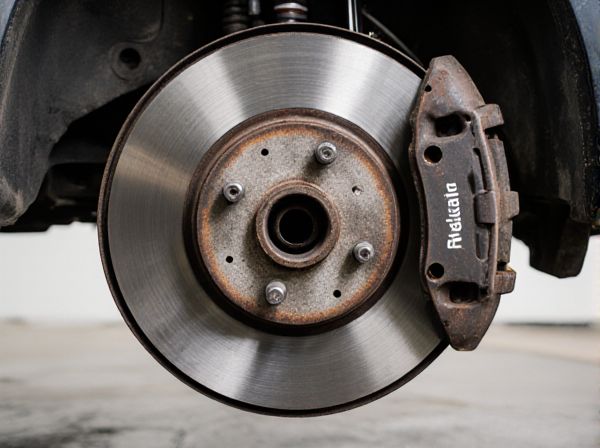
Photo illustration: Drum vs Disc
Drum brakes use a set of brake shoes that press outward against a spinning drum to create friction, offering reliable stopping power but often requiring more maintenance due to wear inside the drum. Disc brakes feature a caliper that squeezes brake pads against a spinning rotor, providing better heat dissipation, improved performance in wet conditions, and easier replacement. Your vehicle's braking system choice affects overall safety, handling, and maintenance costs.
Table of Comparison
| Feature | Drum Brakes | Disc Brakes |
|---|---|---|
| Design | Brake shoes inside a drum | Caliper clamps pads onto a rotor |
| Performance | Less effective heat dissipation | Superior heat dissipation and stopping power |
| Maintenance | More complex and time-consuming | Simple, easier to service |
| Cost | Lower initial cost | Higher initial cost |
| Durability | Prone to brake fade under heavy use | Resistant to brake fade |
| Application | Common in rear brakes of older vehicles | Standard in front and modern rear brakes |
Introduction to Drum vs Disc Brakes
Drum brakes feature a set of brake shoes inside a drum that rotates with the wheel, creating friction to slow the vehicle. Disc brakes use a caliper to squeeze brake pads against a spinning disc or rotor, offering more efficient heat dissipation and improved stopping power. The choice between drum and disc brakes influences vehicle braking performance, maintenance requirements, and overall safety.
Key Differences Between Drum and Disc Brakes
Drum brakes use a set of brake shoes that press outward against a rotating drum to create friction, while disc brakes use calipers to squeeze brake pads directly onto a spinning disc or rotor. Disc brakes generally provide better heat dissipation, resulting in improved braking performance and reduced fade during repeated stops. Drum brakes are often more cost-effective and better suited for rear-wheel braking due to their integrated parking brake mechanism.
How Drum Brakes Work
Drum brakes operate by pressing brake shoes outward against a rotating drum attached to the wheel, creating friction that slows the vehicle. The internal components include a wheel cylinder that pushes the shoes apart using hydraulic pressure when the brake pedal is applied. This friction converts kinetic energy into heat, effectively reducing speed or bringing the vehicle to a stop.
How Disc Brakes Work
Disc brakes operate by pressing brake pads against a rotating metal disc (rotor) attached to the wheel hub, creating friction that slows down or stops the vehicle. Hydraulic pressure from the brake fluid pushes the brake caliper pistons, forcing the brake pads to clamp onto the rotor surface with precise and consistent force. This system offers superior heat dissipation and better performance in wet conditions compared to drum brakes, making disc brakes highly effective for modern vehicles.
Performance Comparison: Drum vs Disc
Disc brakes provide superior stopping power and better heat dissipation compared to drum brakes, making them more effective in high-performance and demanding driving conditions. Drum brakes, while often less expensive and offering decent braking force, tend to suffer from brake fade under heavy use due to their enclosed design and poorer heat dissipation. The consistent performance and quicker response time of disc brakes generally make them the preferred choice for modern vehicles requiring reliable braking efficiency.
Maintenance and Durability Considerations
Drum brakes generally require less frequent maintenance due to their enclosed design, which protects components from dirt and debris, enhancing longevity in harsh conditions. Disc brakes offer superior heat dissipation, reducing brake fade and wear, but their exposed rotors may necessitate more regular inspections and cleaning. Durability-wise, drum brakes often outlast disc brakes in heavy-duty applications, whereas disc brakes excel in consistent performance and quicker response in varying weather conditions.
Cost Analysis: Drum vs Disc Brakes
Drum brakes generally offer lower initial costs due to simpler design and reduced manufacturing expenses, making them a budget-friendly option for economy vehicles. Disc brakes, while more expensive upfront, provide better performance and durability, potentially lowering long-term maintenance costs through improved heat dissipation and reduced wear. The cost differential between drum and disc brakes varies by vehicle type and usage, with disc brakes favored for safety and efficiency despite higher replacement prices.
Common Applications for Each Brake Type
Drum brakes are commonly used in light trucks, compact cars, and older vehicle models due to their cost-effectiveness and strong performance in parking brake functions. Disc brakes are preferred in modern passenger cars, motorcycles, and high-performance vehicles for superior stopping power, heat dissipation, and resistance to brake fade. Heavy-duty trucks often combine both brake types, using discs on the front wheels for enhanced control and drums on the rear wheels for durability under heavy loads.
Safety and Reliability Factors
Disc brakes provide superior safety through faster heat dissipation and more consistent stopping power, minimizing the risk of brake fade during prolonged use. Drum brakes, while generally more durable in harsh conditions, are prone to overheating and reduced performance under heavy braking, impacting reliability. The choice between drum and disc brakes significantly affects vehicle safety, with disc brakes being the preferred option for high-performance and emergency stopping scenarios due to their enhanced stability and responsiveness.
Choosing the Right Brake System for Your Needs
Choosing between drum and disc brakes depends on your vehicle type and driving conditions; disc brakes offer superior heat dissipation and stopping power for high-performance or frequent braking scenarios. Drum brakes provide effective braking with lower production costs, making them suitable for lighter vehicles or those with less demanding braking requirements. Consider factors like maintenance ease, brake responsiveness, and typical usage to determine the best system for safety and efficiency.
 caratoz.com
caratoz.com